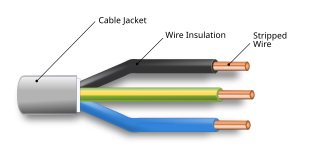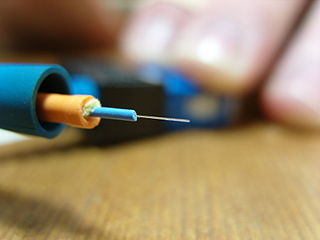
In fiber-optic communication, a single-mode optical fiber (SMF), also known as fundamental- or mono-mode, is an optical fiber designed to carry only a single mode of light - the transverse mode. Modes are the possible solutions of the Helmholtz equation for waves, which is obtained by combining Maxwell's equations and the boundary conditions. These modes define the way the wave travels through space, i.e. how the wave is distributed in space. Waves can have the same mode but have different frequencies. This is the case in single-mode fibers, where we can have waves with different frequencies, but of the same mode, which means that they are distributed in space in the same way, and that gives us a single ray of light. Although the ray travels parallel to the length of the fiber, it is often called transverse mode since its electromagnetic oscillations occur perpendicular (transverse) to the length of the fiber. The 2009 Nobel Prize in Physics was awarded to Charles K. Kao for his theoretical work on the single-mode optical fiber. The standards G.652 and G.657 define the most widely used forms of single-mode optical fiber.

A transmission medium is a system or substance that can mediate the propagation of signals for the purposes of telecommunication. Signals are typically imposed on a wave of some kind suitable for the chosen medium. For example, data can modulate sound, and a transmission medium for sounds may be air, but solids and liquids may also act as the transmission medium. Vacuum or air constitutes a good transmission medium for electromagnetic waves such as light and radio waves. While material substance is not required for electromagnetic waves to propagate, such waves are usually affected by the transmission media they pass through, for instance, by absorption or reflection or refraction at the interfaces between media. Technical devices can therefore be employed to transmit or guide waves. Thus, an optical fiber or a copper cable is used as transmission media.

An electrical cable is an assembly of one or more wires running side by side or bundled, which is used to carry electric current.

In computer networking, Gigabit Ethernet is the term applied to transmitting Ethernet frames at a rate of a gigabit per second. The most popular variant, 1000BASE-T, is defined by the IEEE 802.3ab standard. It came into use in 1999, and has replaced Fast Ethernet in wired local networks due to its considerable speed improvement over Fast Ethernet, as well as its use of cables and equipment that are widely available, economical, and similar to previous standards. The first standard for faster 10 Gigabit Ethernet was approved in 2002.

An optical fiber connector joins optical fibers, and enables quicker connection and disconnection than splicing. The connectors mechanically couple and align the cores of fibers so light can pass. Better connectors lose very little light due to reflection or misalignment of the fibers. In all, about 100 different types of fiber optic connectors have been introduced to the market.

Multi-mode optical fiber is a type of optical fiber mostly used for communication over short distances, such as within a building or on a campus. Multi-mode links can be used for data rates up to 100 Gbit/s. Multi-mode fiber has a fairly large core diameter that enables multiple light modes to be propagated and limits the maximum length of a transmission link because of modal dispersion. The standard G.651.1 defines the most widely used forms of multi-mode optical fiber.

An optical fiber, or optical fibre in Commonwealth English, is a flexible, transparent fiber made by drawing glass (silica) or plastic to a diameter slightly thicker than that of a human hair. Optical fibers are used most often as a means to transmit light between the two ends of the fiber and find wide usage in fiber-optic communications, where they permit transmission over longer distances and at higher bandwidths than electrical cables. Fibers are used instead of metal wires because signals travel along them with less loss; in addition, fibers are immune to electromagnetic interference, a problem from which metal wires suffer. Fibers are also used for illumination and imaging, and are often wrapped in bundles so they may be used to carry light into, or images out of confined spaces, as in the case of a fiberscope. Specially designed fibers are also used for a variety of other applications, some of them being fiber optic sensors and fiber lasers.

Fiber to the x or fiber in the loop is a generic term for any broadband network architecture using optical fiber to provide all or part of the local loop used for last mile telecommunications. As fiber optic cables are able to carry much more data than copper cables, especially over long distances, copper telephone networks built in the 20th century are being replaced by fiber.
Optical networking is a means of communication that uses signals encoded in light to transmit information in various types of telecommunications networks. These include limited range local-area networks (LAN) or wide-area networks (WAN), which cross metropolitan and regional areas as well as long-distance national, international and transoceanic networks. It is a form of optical communication that relies on optical amplifiers, lasers or LEDs and wave division multiplexing (WDM) to transmit large quantities of data, generally across fiber-optic cables. Because it is capable of achieving extremely high bandwidth, it is an enabling technology for the Internet and telecommunication networks that transmit the vast majority of all human and machine-to-machine information.
Ethernet in the first mile (EFM) refers to using one of the Ethernet family of computer network technologies between a telecommunications company and a customer's premises. From the customer's point of view, it is their first mile, although from the access network's point of view it is known as the last mile.

Light tubes are structures that transmit or distribute natural or artificial light for the purpose of illumination and are examples of optical waveguides.

Fiber-optic communication is a method of transmitting information from one place to another by sending pulses of infrared light through an optical fiber. The light is a form of carrier wave that is modulated to carry information. Fiber is preferred over electrical cabling when high bandwidth, long distance, or immunity to electromagnetic interference is required. This type of communication can transmit voice, video, and telemetry through local area networks or across long distances.

A fiber-optic cable, also known as an optical-fiber cable, is an assembly similar to an electrical cable but containing one or more optical fibers that are used to carry light. The optical fiber elements are typically individually coated with plastic layers and contained in a protective tube suitable for the environment where the cable is used. Different types of cable are used for optical communication in different applications, for example long-distance telecommunication or providing a high-speed data connection between different parts of a building.
Networking cables are networking hardware used to connect one network device to other network devices or to connect two or more computers to share devices such as printers or scanners. Different types of network cables, such as coaxial cable, optical fiber cable, and twisted pair cables, are used depending on the network's topology, protocol, and size. The devices can be separated by a few meters or nearly unlimited distances.

10 Gigabit Ethernet is a group of computer networking technologies for transmitting Ethernet frames at a rate of 10 gigabits per second. It was first defined by the IEEE 802.3ae-2002 standard. Unlike previous Ethernet standards, 10 Gigabit Ethernet defines only full-duplex point-to-point links which are generally connected by network switches; shared-medium CSMA/CD operation has not been carried over from the previous generations Ethernet standards so half-duplex operation and repeater hubs do not exist in 10GbE. The first standard for faster 100 Gigabit Ethernet links was approved in 2010.
Thunderbolt is the brand name of a hardware interface for the connection of external peripherals to a computer. It has been developed by Intel, in collaboration with Apple. It was initially marketed under the name Light Peak, and first sold as part of an end-user product on 24 February 2011.
10G-PON is a 2010 computer networking standard for data links, capable of delivering shared Internet access rates up to 10 Gbit/s over existing dark fiber. This is the ITU-T's next generation standard following on from GPON or Gigabit-capable PON. Optical fibre is shared by many subscribers in a network known as FTTx in a way that centralises most of the telecommunications equipment, often displacing copper phone lines that connect premises to the phone exchange. Passive optical network (PON) architecture has become a cost-effective way to meet performance demands in access networks, and sometimes also in large optical local networks for "Fibre-to-the-desk".
Cladding in optical fibers is one or more layers of materials of lower refractive index in intimate contact with a core material of higher refractive index. The cladding causes light to be confined to the core of the fiber by total internal reflection at the boundary between the core and cladding. Light propagation within the cladding is typically suppressed for most fibers. However, some fibers can support cladding modes in which light propagates through the cladding as well as the core. Depending upon the quantity of modes that are supported, they are referred to as multi-mode fibers and single-mode fibers. Improving transmission through fibers by applying a cladding was discovered in 1953 by Dutch scientist Bram van Heel.
A fiber-optic patch cord is a fiber-optic cable capped at either end with connectors that allow it to be rapidly and conveniently connected to CATV, an optical switch or other telecommunication equipment. Its thick layer of protection is used to connect the optical transmitter, receiver, and the terminal box. This is known as "interconnect-style cabling".
Subisu Cablenet Ltd. is a Nepalese Internet Service Provider company located in Kathmandu, Nepal, and was established in 2001. Subisu employs over 1500 full-time employees, of which around 900 are technical, and around 700 are non-technical. As of 2023, the company has over 235,000 customers. It has coverage at all 77 districts of Nepal. Subisu primarily provides cable & fiber internet and Digital TV services through a hybrid fiber-coaxial (HFCC) network. Internet and 280+ TV channels that it offers provides a strong spine to Nepal's educational, entertainment, professional and other sectors. It is the first and the only cable internet service provider in Nepal.












